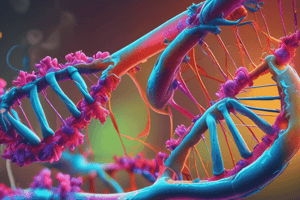Podcast
Questions and Answers
What is a mutagen?
What is a mutagen?
A mutagen refers to any agent found in an organism's environment capable of producing genetic mutations in DNA.
What are some DNA repair mechanisms?
What are some DNA repair mechanisms?
Some DNA repair mechanisms include base excision repair (BER), nucleotide excision repair (NER), and mismatch repair (MMR).
When does base excision repair occur?
When does base excision repair occur?
Base excision repair occurs during the G1 stage of the normal cell cycle.
When does nucleotide excision repair occur?
When does nucleotide excision repair occur?
What is the purpose of mismatch repair?
What is the purpose of mismatch repair?
What does the term mutagenic mean?
What does the term mutagenic mean?
What are some sources of mutagenic agents?
What are some sources of mutagenic agents?
What are some examples of physical mutagens?
What are some examples of physical mutagens?
What are some examples of chemical mutagens?
What are some examples of chemical mutagens?
What are some examples of biological mutagens?
What are some examples of biological mutagens?
What are free radicals and how do they form?
What are free radicals and how do they form?
How do thymine dimers prevent the formation of the double helix?
How do thymine dimers prevent the formation of the double helix?
What is xeroderma pigmentosum and how is it caused?
What is xeroderma pigmentosum and how is it caused?
What are chemical mutagens and how do they impact DNA?
What are chemical mutagens and how do they impact DNA?
Give an example of a chemical mutagen and the type of damage it causes to DNA.
Give an example of a chemical mutagen and the type of damage it causes to DNA.
What are biological mutagens and how do they cause mutations?
What are biological mutagens and how do they cause mutations?
What is an example of a biological mutagen and the impact it has on human health?
What is an example of a biological mutagen and the impact it has on human health?
What is the process of alkylation and its impact on DNA?
What is the process of alkylation and its impact on DNA?
What is the process of oxidation and its impact on DNA?
What is the process of oxidation and its impact on DNA?
How do mutations contribute to the process of evolution?
How do mutations contribute to the process of evolution?
Flashcards are hidden until you start studying




